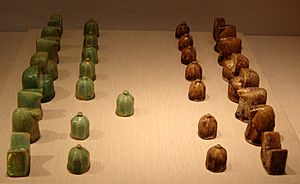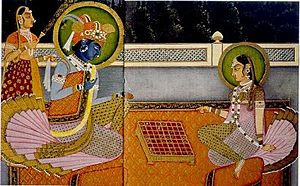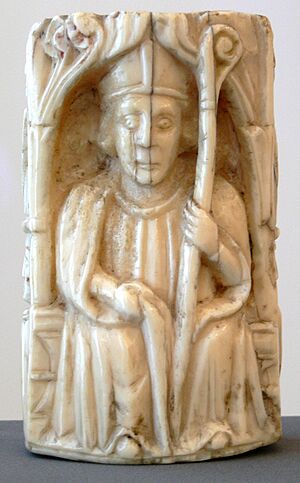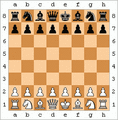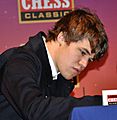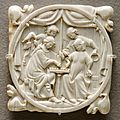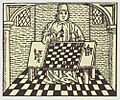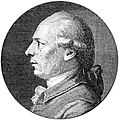History of chess facts for kids
The history of chess is a fascinating journey that spans over 2000 years. An early version of chess, called XiangQi, was played in China around 200 BC. However, the modern game of chess we know today began in northern India in the 6th century AD. From India, it traveled to Persia.
When the Arabs conquered Persia, they learned chess and helped spread it across the Muslim world. Through the Moors (Muslims from North Africa) who conquered Spain, chess reached Southern Europe. In early Russia, the game arrived directly from Muslim territories to the south.
In Europe, the way chess pieces moved changed a lot in the 15th century. These changes led to the modern game. Later, in the 1800s, organized tournaments started. Special chess clocks were first used in 1883, and the very first world chess championship was held in 1886. The 20th century brought new ideas about chess strategy and the creation of the World Chess Federation (FIDE). Also, computer programs that play chess (called chess engines) and chess databases became very important.

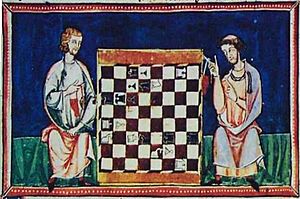
Contents
Key Moments in Chess History
Here are some important dates in the history of chess:
- 550 AD: Chess is first played in Northwestern India.
- 600 AD: The first clear mention of chess appears in a Persian manuscript. It describes chess coming to Persia (Iran) from India.
- ~700 AD: The oldest known chess pieces are created.
- 800 AD: The Moors bring chess to Spain and Sicily.
- 900 AD: Early Muslim chess masters write books about how to play chess better.
- 1000 AD: Chess is played widely across Europe, including Russia.
- 1300 AD: Europeans start writing about chess in stories and sermons.
- 1475–1500 AD: The modern game is born! The Queen and Bishop get their powerful new moves.
- 1495: The first chess book is printed.
- 1497: The first printed chess book that we still have today is published.
- 1600: The first professional chess players who also wrote about the game appear.
- 1780s: The first master games are written down as they are played.
- 1836: The first chess magazine is published.
- 1849: The first US chess tournament is held.
- 1851: The first international chess tournament takes place.
- 1866: The first chess match is timed using a clock.
- 1883: The first tournament uses special chess clocks.
- 1886: The first official world championship match is played.
- 1927: The first Chess Olympiad (a team tournament) is organized by FIDE.
- 1960: Players start getting official numerical ratings to show their skill level.
Where Did Chess Come From?
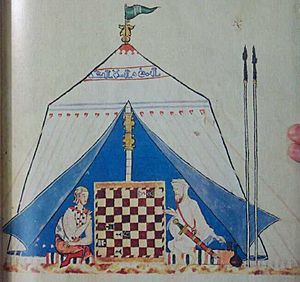
The very first versions of chess began in northern India during the Gupta Empire. This early form, from the 6th century, was called Chaturanga. This name means 'the four divisions'. It referred to the four parts of an army: infantry (foot soldiers), cavalry (horse riders), elephantry (elephants), and chariotry (chariots). These pieces later became the modern pawn, knight, bishop, and rook.
Chess in Persia and the Arab World
Around 600 AD, in Persia (modern-day Iran), the game was called Chatrang. The rules were further developed. Players started saying Shāh! (Persian for 'King') when they attacked the opponent's king. They would say Shāh māt! (Persian for 'the king is finished') when the king couldn't escape the attack. These phrases are still used in chess today!
After the Islamic conquest of Persia, the game was adopted by the Muslim world. The pieces mostly kept their Persian names. In Arabic, "māt" or "māta" means "died" or "is dead". The game became known as Shatranj. In almost all other languages, the name of the game comes from either shatranj or shah.
How Piece Names Changed
Over centuries, as chess traveled from India through Persia to Europe, the names and roles of the pieces changed. Pieces that didn't have an equivalent in Europe, like the elephant or the visier (an advisor), got new names. For example, the elephant piece eventually became the "bishop" in most European languages. The visier became the "queen," and the chariot became the "castle" or "rook."
Here's a look at how some names changed:
| Sanskrit | Persian | Arabic | English | Spanish | French | Italian |
|---|---|---|---|---|---|---|
| Raja (King) | Shah | Shah | King | Rey | Roi | Re |
| Mantri (Minister) | Vazir/Vizir | Wazir/Firzān | Queen | Reina | Reine | Regina |
| Hasty/Gajah (elephant) | Pil | Al-Fil | Bishop | Alfil | Fou | Alfiere |
| Ashva (horse) | Asp | Fars/Hisan | Knight | Caballo | Cavalier | Cavallo |
| Ratha (chariot) | Rukh | Rukh | Rook | Torre | Tour | Torre |
| Padati (footsoldier) | Piadeh | Baidaq | Pawn | Peón | Pion | Pedone |
Chess Spreads to Europe and the East
Chess reached Western Europe and Russia by at least three different paths, starting in the 9th century. By the year 1000, it was played all over Europe. The Moors brought it to the Iberian Peninsula (Spain and Portugal) in the 10th century. A famous 13th-century book called Libro de los juegos described shatranj, backgammon, and dice.
Buddhist pilgrims, Silk Road traders, and others carried chess to the Far East. There, it changed into games often played on the intersections of lines on the board, not inside the squares. Chinese chess and Shogi are the most important of these Asian chess games. However, it was the changes made in medieval Europe that led to our modern game.
How the Rules Changed
The game of chess is actually like two different games. There's the original Indo-Arabic game, and then there's the modern game, which we call 'international chess'. The change happened in Europe during the late 15th century, as the medieval world transitioned to the modern world. In fact, the new game of chess was one of the first topics to be printed using the new technology of printing.
The Old Indo-Arabic Game
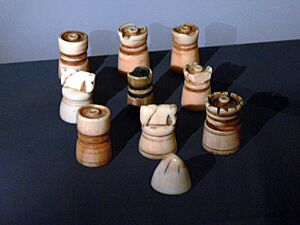
around 10th century
| a | b | c | d | e | f | g | h | ||
| 8 |
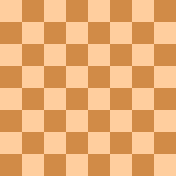
|
8 | |||||||
| 7 | 7 | ||||||||
| 6 | 6 | ||||||||
| 5 | 5 | ||||||||
| 4 | 4 | ||||||||
| 3 | 3 | ||||||||
| 2 | 2 | ||||||||
| 1 | 1 | ||||||||
| a | b | c | d | e | f | g | h | ||
In early chess, the pieces moved differently:
- Shāh (King): Moved like the King does today.
- Firzān (Queen): Could only move one square diagonally at a time. This is very different from our powerful modern Queen!
- Fīl (Bishop): Could only move exactly two squares diagonally. It could jump over a piece in between. This meant a Fīl could only reach eight squares on the whole board, and no Fīl could ever attack another Fīl.
- Horseman (Knight): Moved like the Knight does today.
- Rukh (Rook): Moved like the Rook does today.
- Pawn: Could only move one square forward (not two on its first move). It captured one square diagonally forward. A pawn could only be promoted to a Firzān (the old Queen).
In the old game, you could win by: 1. Checkmating the king; 2. Creating a stalemate (where the king has no legal moves but is not in check); or 3. Capturing all of the opponent's pieces. This third rule helped prevent too many drawn games.
Big Changes in Europe
In Europe, some pieces got new names:
- The Mantri/Firzan/Vizir became the Queen. This might be because it started next to the King.
- The Fīl became the Bishop. Its two points looked like a bishop's mitre (hat). In French, it's called fou.
About 500 years after chess first arrived in Europe, major changes were made to how the pieces moved. These changes made the game start faster and brought the pieces into contact sooner. The main changes were:
- Pawn's first move: Pawns could now move two squares forward on their first move. This led to the en passant rule, where a pawn can capture an enemy pawn that has moved two squares past it.
- King's jump: The King was allowed to make one special "jump" move to get to safety faster. This eventually led to the castling rule.
- The Queen: This was the biggest change! The old Queen (Firzān) was a weak piece, only moving one square diagonally.
* At first, the Queen got a small upgrade: an initial move of two squares diagonally, with a jump. This was sometimes given to new Queens made by promoting a pawn. * Then came the full-ranging movement of the Queen, allowing her to move any number of squares along diagonals, ranks (rows), and files (columns). This was such a huge change that some people called the new game eschés de la dame enragée (the mad queen's game) in French, and schacci alla rabioso (furious chess) in Italian. This change made the game much more exciting and dynamic.
These new rules made most of the old chess strategies useless. The slow starts of the game were replaced by quick attacks and gambits (sacrificing a pawn early for an advantage). The relative values of the pieces changed a lot. Now, the game can only be won by checkmate or if one player resigns.
Old Books and Manuscripts
The first printed chess book that still exists today is Luis de Lucena's Arte de axedres, printed in Spain around 1496 or 1497. It had chess problems using both the old rules and the new "Queen's game" rules. This shows that the change was still happening, and some readers might not have known the new rules yet.
By 1512, when Damiano published his chess book in Rome, it only included problems with the new rules. This means the modern game was becoming very popular. England and Germany adopted the new game by 1530. After that, the old game mostly disappeared in Europe, though a version survived in India until more recently.
How Chess Strategy Developed
Modern chess strategy took a while to develop. After the new moves for the pieces, players mostly focused on playing gambits and trying to checkmate each other quickly. The games of Gioacchino Greco (early 1600s) show this direct style.
The first ideas about winning indirectly, or 'positionally' (by controlling key areas of the board), started with Philidor. Interestingly, modern chess involves a lot of indirect maneuvering, which the old Arabic players would have understood. They couldn't attack directly because their Alfil (old bishop) and Firzān (old queen) had such limited moves.
The Arabs also divided their game into the same three stages we use today: the opening, the middlegame, and the endgame.
Tabiyat
In the old Arabic game, masters would make several moves at the start before their pieces even touched the opponent's. They would memorize common starting positions, called ta'biya (plural: ta'biyat or ta'abi), which means battle-array. These were like model setups for their pieces.
How Piece Values Changed
The new rules greatly changed how powerful each piece was.
| Shatranj (Old Game) | Value | Modern Chess | Value | |
|---|---|---|---|---|
| Baidaq (Pawn) | 1 | Pawn | 1 | |
| Faras (Knight) | 4 | Knight | 3 | |
| Fīl (Bishop) | 1.5 | Bishop | 3 | |
| Rūkh (Rook) | 6 | Rook | 5 | |
| Firz (Queen) | 2 | Queen | 9 |
This table shows that the modern game uses much more "force" on the board than the old game. This is because of the Queen's new power, the Pawn's ability to move two squares at first, and the castling rule. The faster development of pieces also makes the opening stage much more important in modern chess.
Clues from Archaeology
When archaeologists find old objects, it can be tricky to tell if they are chess pieces. A single small carving might just be an art object. However, if they find a group of small objects, especially if there are more than two different types, it's more likely to be chess pieces. Most board games only use two kinds of pieces, but chess uses six different kinds. If the pieces look like typical chess figures (like foot soldiers, kings, or people on horses), it's even more convincing.
Evidence from archaeology comes mainly from finding early chess sets and also from rock art (carvings or paintings on rock).
The Afrasiab Chess Pieces
The oldest known chess pieces are from the Afrasiab collection. In 1977, archaeologists dug at Afrasiab, near Samarkand in Uzbekistan. Samarkand is a very old city on the Silk Road, a major trade route between China and the Mediterranean. It was a perfect place for traders to store valuable goods.
The Afrasiab finds include seven chess pieces. They are quite worn, but you can still see what they represent:
- Two foot soldiers with shields and short swords (our pawns).
- A war elephant with chain armour and a rider (our bishop).
- A visier (our queen) with two horses and an armed rider.
- Two mounted riders with sword and shield (knights).
- The Shah (our king) on a three-horse chariot, holding a mace (a symbol of power).
This is five out of the six types of pieces, making it a very strong clue that it's a chess set. The rukh (rook) piece is also known from descriptions: it showed a three-horse chariot with two men, one driving and the other armed.
These pieces are from the 7th or 8th centuries, probably from the end of the Sassanid Empire, just before the Arab conquest. They are representational, meaning they are small carvings of war figures and equipment. Later, Arabic chess sets became more abstract shapes, due to religious teachings.
Images for kids
-
The 12th-century Lewis chessmen in the collection of the National Museum of Scotland.
-
The Chess Players by Henry Fox Talbot, 1847.
-
Stamp of the USSR devoted to the accomplished Estonian player and analyst Paul Keres, 1991.
-
Animation of the Immortal Game, in which Adolf Anderssen, playing white, beat Lionel Kieseritzky in June 1851.
-
Wilhelm Steinitz, the first official World Chess Champion.
-
World Champions José Raúl Capablanca (left) and Emanuel Lasker in 1925.
-
Current World Champion Magnus Carlsen.
-
Persian manuscript from the 14th century describing how an ambassador from India brought chess to the Persian court.
-
Shams-e-Tabrīzī as portrayed in a 1500 painting in a page of a copy of Rumi's poem dedicated to Shams.
-
Knights Templar playing chess, Libro de los juegos, 1283.
See also
 In Spanish: Historia del ajedrez para niños
In Spanish: Historia del ajedrez para niños


